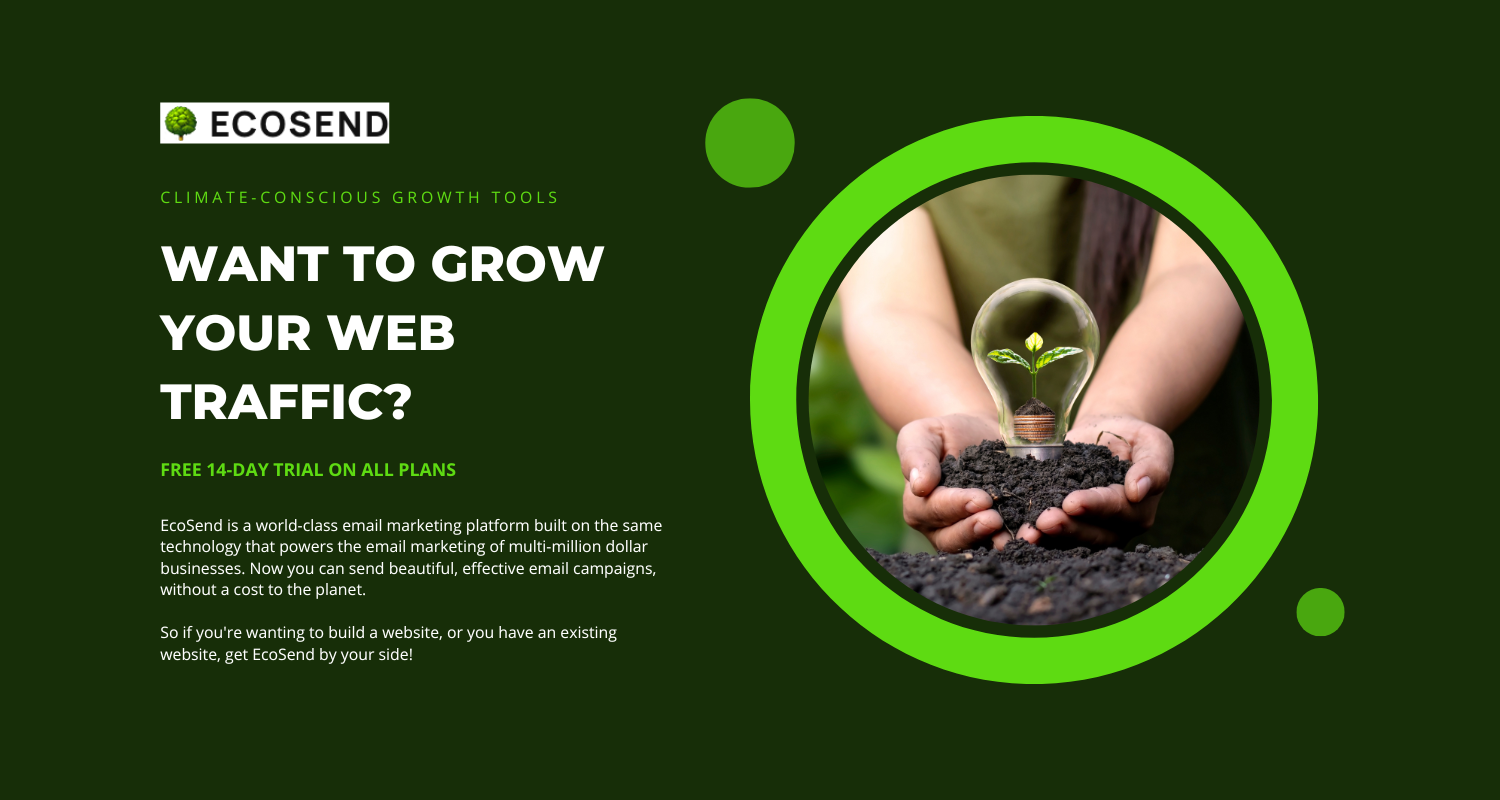Did you know there are 1.8 billion websites in existence?
So if you’re thinking of joining the party, you’re in good company. Though, if you’re new to building websites, or looking to refresh your existing website, it can be difficult to know where to start.
Allow us to lend an ear. We’ve recently finished building our own website EcoSend which is a new tool by GoSquared.
So with us fresh out of the process, and our team equally having a combination of business, marketing, design and SEO expertise, here are our top tips for website building success in 2023 and beyond.
First Of All: Why Would You Want A Website?
- A website is the digital face of your brand or business.
- Websites are also amazing for personal development.
- Builds connections with like-minded individuals around the world.
- Can ensure that when prospective clients/employers Google you, they find the right type of content.
- Unlike with social media platforms, you actually own your website.
- There are endless ways to develop your website including making money through it.
- Anyone can start a website!
Pick A Niche

Most people base their website around their business. But you may also want to start a personal blog that highlights things you’re interested in.
For example, EcoSend which we just mentioned above is a sustainable email marketing platform.
Whatever you want to share with the world, it always helps when a website has a clear focus on what it’s about, along with who the content is aimed at. Because then, everything you add to it, and even its design will align with these basic goals.
Ideally, your website niche should be something that you can grow and develop over time, rather than being super limited in potential or even outdated. So, put in a little research on what’s already out there if you’re unsure.
Also, if you plan on making money through your website – figure out how this can be achieved before you start building to ensure your platform will be compatible. More on this below under ‘Consider Monetising Your Website’.
Decide How You’re Going To Build Your Website
There really are only two options when it comes to building a website. The traditional method is to hand everything over to professional developers and designers.
The other is adopting a DIY approach by using the likes of WordPress templates, Wix, Squarespace or the GoDaddy website builder.
Here is what you need to consider before you decide which avenue is right for you.
Purchasing A Custom Coded Fully Designed Website

Pros:
- Your website will benefit from a fresh perspective, with every decision made with expert eyes. The design and functionality will likely look way more professional.
- The finished result will look unique, which can’t be achieved when using a cookie cutter design such as popular website themes and templates.
- You don’t have to stress about the technical elements, or even the design because it will all be taken care of for you.
- Tools such as Figma are not only highly interactive, but also collaborative so that each member of the team can access the design.
- The individual or agency may be able to offer ongoing support services.
Cons:
- Custom built websites can be very expensive, especially if you employ the very best agencies.
- Custom features may mean more headaches that aren’t easy to solve because you’re not using standard tools and technologies.
- While you’re still the client, you’ll need to hand over creative control to the experts, so may not suit entrepreneurs with an exact vision of what they want.
- Not all creative agencies are created equal – you have to be sure you are working with true professionals.
Building Your Own Website With A Drag And Drop Editor Or A Template Theme

Pros:
- The cost of building your website will be significantly less because you aren’t hiring professionals.
- You can get the website up and running almost instantly, especially for blogs or super basic websites with only a few pages.
- No need to understand coding.
- Endless templates to choose from.
Cons:
- You may still need some technical ability as some elements can still be a little tricky, i.e. purchasing and installing an SSL certificate or fixing general glitches.
- If you don’t have any design skills you may struggle to create a professional looking website.
- Some website hosting platforms have limited design and SEO capabilities.
- Your website must be responsive, meaning it looks just as good on mobile devices as it does on desktop – if your chosen template or theme doesn’t do this automatically it can take a lot of work to get right.
- It can take a lot of time to build and maintain a website.
So, think carefully about which option will really cost you more before you go ahead and start a website.

Choose A Hosting Platform & Domain Name
Every website needs a place where it is hosted, along with a domain name so that it can have a URL where people can find it.
Examples of hosting providers include 123 Reg, Bluehost, Dreamhost, GoDaddy and SiteGround. Though, some website building platforms will include hosting and domain names as part of one package.
As for domain names specifically, take your time to research the most appropriate name. It should be something that’s easy to say, spell and remember. Avoid typos or dashes.
Also, take the time to understand domain name suffixes. Some may limit where your website is shown, and others could put you on the spam list.
If you’re in the UK: Check if the name is also available on Companies House, especially if you plan on creating a company based on your website.
Plan Out The Website Content In A Separate Document

As an SEO content writer, this is how I structure every web content writing project:
I type out a list of pages to create a site structure on a Google Doc. I then separate each page with a coloured line so that the developer can paste my content into the website with ease.
Each page of a website will then have clear SEO headings (i.e. H1-H6 tags), meta descriptions and anything else of interest mapped out. My preference is to do all of this before the design so that I can work with designers and developers to iron out every detail.
Having the written content in front of you really helps to ensure you’re saying the right things, and setting the right tone. All pages should have at least 150 words of content to avoid Google’s ‘low content’ warning. Though, I will decide on the word count based on the niche and overall SEO keyword difficulty, among a few other factors.
Resist the temptation to type into your website text boxes directly (for drag-and-drop editors or WordPress themes). It’s impossible not to make typos this way, and the flow will likely be off.
The only exception to this rule is headings which have a short character count (still get someone to check your spelling though).
Design & Build Your Website

Once you have your site structure and content already mapped out, it’s going to be much easier to build your website around this existing framework.
At this point, you need to think about the design. Based on which option you chose above, either you’ve hired an agency to design your website, or you’ll be selecting a template theme to work with yourself.
Review the design carefully before publishing it to go live. Make sure basic errors such as broken links or lorem ipsum text have been removed.
Also, check page load times. If you want to attract website visitors from overseas, you may need a CDN (content delivery network) to speed up the time it takes for your content to load.
Create An Ongoing SEO Strategy
Even the most beautiful website in the world won’t be found automatically. Instead, you need to implement a solid SEO strategy from the get-go.
Your aim is to encourage backlinks and gradually build domain authority over time. If your website is brand new and the domain age is under 1 year, brace yourself for the long haul.
SEO software is essential to research keywords, keyword difficulty and keyword search volumes.
There’s far too much to summarise about SEO in one heading. But in a nutshell, whatever users type into Google should align perfectly with what they find on your page. This will ensure your visitors stay on your pages because you’re giving them what they were expecting to find.
It’s possible to implement good SEO practices in all aspects of your website. Consult an expert if you’re unsure, as SEO will make or break how easy it is for users to find you online.
Invest In Other Growth Tools To Bring Traffic To Your Website

SEO is one of many tools you can use to increase traffic to your website. The more methods you employ, the more successful your website is likely to be.
Email marketing – Did you know over 4 billion people have an email account? The likes of welcome emails, newsletters and general email marketing campaigns can all help to bring traffic to your website. Add a form to your website to capture subscribers and build your lists.
P.S: Both GoSquared Engage and EcoSend by GoSquared can be used for all your email marketing needs!
Social media – Twitter, Instagram, Facebook, Tik Tok, Pinterest – take your pick! Add social icons to your website to facilitate easy follows and shares.
Guest posting – Write articles to be posted on other websites which give a link back to your website (backlinking). The higher the domain authority of that website the better.
Video marketing – Videos remain highly engaging assets you can embed on your website. Quite simply, video helps build that human connection. Plus, the ability to monetise videos uploaded to YouTube is yet another way to grow your revenue.
LinkedIn – Write articles and post content that has a direct link back to your website.
Business cards – The only fashioned way of doing business! Perfect if you attend any networking events, or offer your services in person.
QR codes – The modern version of a business card is of course a QR code. Place QR codes anywhere and everywhere to get users instantly on your site.
Word of mouth – If you create a website, don’t forget to tell everyone you know about it!
Consider Monetising Your Website

The final step of building a website relates to ensuring your maximising any revenue streams through it.
After all, you aren’t just creating a website for fun. For most people, they use their website to generate an income, whether this is directly or indirectly.
Now your website is live, consider the following ways of building growth and ultimately profit through it.
- Affiliate marketing – here are 17 affiliate marketing programs to get you started.
- Advertising your services
- Hosting advertising on your website
- Paid guest posts
- Retargeting
- Selling products
For personal websites, many people use their website to showcase their talent. This is yet another way of generating revenue indirectly through a website. So although you may not sell products or run ads, a website can still be an incredible tool for your career progression.
Building A Website In 2023: Our Top Tips For Success
- Don’t spend all the budget on a website design, but neglect your written copy or SEO. It’s far better to scale back the design rather than have poorly written copy, or no strategy to attract search traffic to your website.
- Make sure your landing page (home page) is an elevator pitch of your personal brand or your business. If a brand new user can’t immediately understand what it is that you do or offer, it’s not hitting the brief. If in doubt, get out of your own head and ask for advice. Remember just because you understand your business or idea, doesn’t mean others automatically will.
- Be prepared to put work into your website over the long haul. It takes time to build visitors and backlinks, let alone conversions!
Grow Your Website With GoSquared

Since 2006, GoSquared has helped new and existing businesses (and their websites!) to flourish. We can provide you with a number of tools to help grow your website and monitor your traffic.
If you’re wanting to grow your website traffic by keeping your subscribers up to date with your latest news, blog posts, promotions and more, then check out Engage. This is our customer engagement platform that makes all things email marketing a breeze.
Or to monitor your website traffic so you can best understand how users are finding your site, plus what they do once they are on there, Analytics has got you covered.
Finally, how could we forget? Our new tool we mentioned at the start EcoSend is here to offset your carbon emissions from your digital marketing efforts.
Need help with anything we’ve mentioned above? Please fill out our contact form and one of our growth specialists will be in touch.


